Related Research Articles
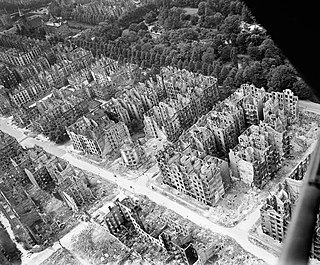
The Allied bombing of Hamburg during World War II included numerous attacks on civilians and civic infrastructure. As a large city and industrial centre, Hamburg's shipyards, U-boat pens, and the Hamburg-Harburg area oil refineries were attacked throughout the war.

The Channel Dash was a German naval operation during the Second World War. A Kriegsmarine squadron comprising the two Scharnhorst-class battleships, the heavy cruiser Prinz Eugen and their escorts was evacuated from Brest in Brittany to German ports. Scharnhorst and Gneisenau had arrived in Brest on 22 March 1941 after the success of Operation Berlin in the Atlantic. More raids were planned and the ships were refitted at Brest. The ships were a threat to Allied trans-Atlantic convoys and RAF Bomber Command attacked them from 30 March 1941. Gneisenau was hit on 6 April 1941 and Scharnhorst on 24 July 1941, after dispersal to La Pallice. In late 1941, Adolf Hitler ordered the Oberkommando der Marine to plan an operation to return the ships to German bases against a British invasion of Norway. The short route up the English Channel was preferred to a detour around the British Isles for surprise and air cover by the Luftwaffe and on 12 January 1942, Hitler gave orders for the operation.

Operation Sportpalast, also known as Operation Nordmeer, was a German naval raid between 6 and 13 March 1942 against two of the Allied Arctic convoys of World War II as they passed through the Norwegian Sea. It was conducted by the battleship Tirpitz, three destroyers and eight submarines. The German ships were unable to locate either of the convoys but sank a merchant vessel that was sailing independently. The Allies attempted to intercept the German force, also without success.

Operation Cockpit was an Allied attack against the Japanese-held island of Sabang on 19 April 1944. It was conducted by aircraft flying from British and American aircraft carriers and targeted Japanese shipping and airfields. A small number of Japanese ships and aircraft were destroyed, and one American aircraft was lost. While the attack was successful tactically, it failed to divert Japanese forces from other areas as had been hoped.

Operation Tungsten was a Second World War Royal Navy air raid that targeted the German battleship Tirpitz. The operation sought to damage or destroy Tirpitz at her base in Kaafjord in the far north of Norway before she could become fully operational again following a period of repairs.
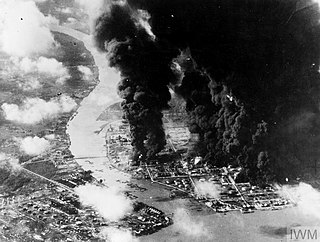
Operation Meridian, also known as the "Palembang Raids" was part of a series of British air attacks directed at Japanese-held oil refineries near Palembang on Sumatra during the Second World War, Meridian had two phases: Meridian I on 24 January 1945 and Meridian II on 29 January. As a result, the critical aviation fuel output of the plants at Palembang was reduced by seventy-five percent.

The Battle of Berlin was a bombing campaign against Berlin by RAF Bomber Command along with raids on other German cities to keep German defences dispersed. Air Chief Marshal Sir Arthur Harris, Air Officer Commanding-in-Chief (AOC-in-C) Bomber Command, believed that "We can wreck Berlin from end to end if the USAAF come in with us. It will cost us between 400 and 500 aircraft. It will cost Germany the war".
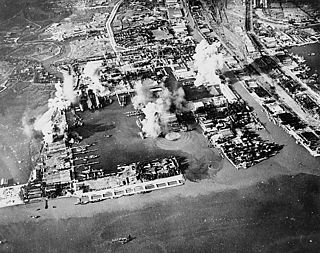
Operation Transom was an attack by Allied forces against the Japanese-occupied city of Surabaya on the Indonesian island of Java during World War II. Conducted by the British-led Eastern Fleet, the operation took place on 17 May 1944 and involved American and British carrier-based aircraft bombing the city's docks and an oil refinery. An American torpedo bomber was shot down, and two British torpedo bombers were lost in accidents.

Operation Paravane was a British air raid of World War II that inflicted heavy damage on the German battleship Tirpitz, at anchor in Kaafjord in the far north of German-occupied Norway. The attack was conducted on 15 September 1944 by 21 Royal Air Force heavy bombers, which flew from an airfield in the north of the Soviet Union. The battleship was struck by one bomb, and further damaged by several near misses. This damage rendered Tirpitz unfit for combat, and she could not be repaired as it was no longer possible for the Germans to sail her to a major port.

Operation Obviate was an unsuccessful British air raid of World War II which targeted the German battleship Tirpitz. It was conducted by Royal Air Force heavy bombers on 29 October 1944, and sought to destroy the damaged battleship after she moved to a new anchorage near Tromsø in northern Norway.
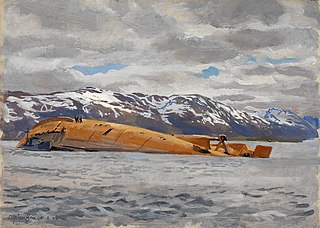
Operation Catechism was a British air raid of World War II that destroyed the German battleship Tirpitz. It was conducted on 12 November 1944 by 29 Royal Air Force heavy bombers that attacked the battleship at its anchorage near the Norwegian city of Tromsø. The ship capsized after being hit by at least two bombs and damaged by the explosions of others, killing between 940 and 1,204 members of the crew; the British suffered no casualties.

The attacks on Kure and the Inland Sea by United States and British naval aircraft in late July 1945 sank most of the surviving large warships of the Imperial Japanese Navy (IJN). The United States Third Fleet's attacks on Kure Naval Arsenal and nearby ports on 24, 25, and 28 July sank an aircraft carrier, three battleships, five cruisers, and several smaller warships. During the same period the British Pacific Fleet attacked other targets in the Inland Sea region and sank two escort ships and several smaller vessels as well as damaging an escort carrier.
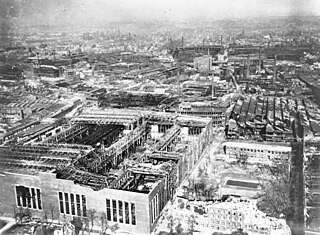
The Battle of the Ruhr was a strategic bombing campaign against the Ruhr Area in Nazi Germany carried out by RAF Bomber Command during the Second World War. The Ruhr was the main centre of German heavy industry with coke plants, steelworks, armaments factories and ten synthetic oil plants. The British attacked 26 targets identified in the Combined Bomber Offensive. Targets included the Krupp armament works (Essen), the Nordstern synthetic oil plant at Gelsenkirchen and the Rheinmetall–Borsig plant in Düsseldorf, which was evacuated during the battle. The battle included cities such as Cologne not in the Ruhr proper but which were in the larger Rhine-Ruhr region and considered part of the Ruhr industrial complex. Some targets were not sites of heavy industry but part of the production and movement of materiel.
Ernst-Georg Drünkler was a German Luftwaffe military aviator during World War II, a night fighter ace credited with 47 aerial victories, including two by day, claimed in 102 combat missions making him the thirtieth most successful night fighter pilot in the history of aerial warfare. The majority of his victories were claimed over the Western Front in Defense of the Reich missions against the Royal Air Force's Bomber Command.

Tirpitz was the second of two Bismarck-class battleships built for Nazi Germany's Kriegsmarine (navy) prior to and during the Second World War. Named after Grand Admiral Alfred von Tirpitz, the architect of the Kaiserliche Marine, the ship was laid down at the Kriegsmarinewerft in Wilhelmshaven in November 1936 and her hull was launched two and a half years later. Work was completed in February 1941, when she was commissioned into the German fleet. Like her sister ship, Bismarck, Tirpitz was armed with a main battery of eight 38-centimetre (15 in) guns in four twin turrets. After a series of wartime modifications she was 2000 tonnes heavier than Bismarck, making her the heaviest battleship ever built by a European navy.

Operation Mascot was an unsuccessful British carrier air raid conducted against the German battleship Tirpitz at her anchorage in Kaafjord, Norway, on 17 July 1944. The attack was one of a series of strikes against the battleship launched from aircraft carriers between April and August 1944, and was initiated after Allied intelligence determined that the damage inflicted during the Operation Tungsten raid on 3 April had been repaired.

Operation Tungsten was a Second World War air raid conducted by the Royal Navy that targeted the German battleship Tirpitz at her base in Kaafjord in the far north of Norway on 3 April 1944.
Operation Mascot was an unsuccessful British carrier air raid conducted against the German battleship Tirpitz at her anchorage in Kaafjord, Norway, on 17 July 1944. Few of the British airmen were able to spot the battleship, and their attacks did not inflict any significant damage. Tirpitz was eventually disabled and then sunk by Royal Air Force heavy bombers later in the year.

Operation Goodwood was a series of British carrier air raids conducted against the German battleship Tirpitz at her anchorage in Kaafjord in occupied Norway during late August 1944. It was the last of several attacks made by the Home Fleet during 1944 which sought to damage or sink Tirpitz and thereby eliminate the threat it posed to Allied shipping. Previous raids on Kaafjord conducted by Fleet Air Arm aircraft had involved only one air attack; in Operation Goodwood several attacks were made in a single week. The Royal Navy hoped that these raids would wear down the formidable German defences.
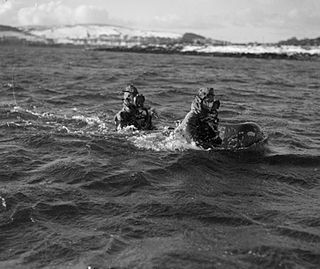
Operation Title was an unsuccessful Allied attack on the German battleship Tirpitz during World War II. It involved two British Chariot manned torpedoes that were transported close to the battleship's anchorage in Trondheimsfjorden, Norway, by a Norwegian-crewed boat between 26 and 31 October 1942. The attack was abandoned following the accidental loss of both Chariots in the evening of 31 October.
References
- Citations
- ↑ Middlebrook and Everitt (1985), p. 90
- ↑ Middlebrook and Everitt (1985), p. 116
- ↑ Middlebrook and Everitt (1985), p. 119
- ↑ Middlebrook and Everitt (1985), p. 128
- ↑ Middlebrook and Everitt (1985), p. 158
- ↑ Middlebrook and Everitt (1985), p. 165
- ↑ Bishop (2012), p. 53
- ↑ Middlebrook and Everitt (1985), p. 233
- 1 2 3 4 5 6 7 8 9 Roskill (1961), p. 170
- ↑ Farmer, Ben (10 December 2014). "Students find lost British WW2 bomber in Norwegian fjord". The Telegraph. Retrieved 12 December 2014.
- ↑ Bennett (2012), p. 13
- ↑ Bennett (2012), pp. 13–14
- ↑ Bishop (2012), p. 295
- 1 2 3 4 5 6 7 8 Roskill (1961), p. 171
- Works consulted
- Bennett, G.H. (2012). "Introduction". In Bennett, G.H. (ed.). Hunting Tirpitz: Naval Operations Against Bismarck's Sister Ship. Plymouth, United Kingdom: University of Plymouth Press. pp. 7–25. ISBN 9781841023106.
- Bishop, Patrick (2012). Target Tirpitz. London: Harper Press. ISBN 9780007431199.
- Middlebrook, Martin; Everitt, Chris (1985). The Bomber Command War Diaries : An Operational Reference Book, 1939–1945 (Repr. ed.). Harmondsworth, Middlesex, England: Viking. ISBN 0670801372.
- Roskill, S.W. (1961). The War at Sea 1939–1945. Volume III: The Offensive Part II. London: Her Majesty's Stationery Office. OCLC 59005418.